Buddhist Women on a Path of Spiritual Awakening
At the Altar of Emptiness
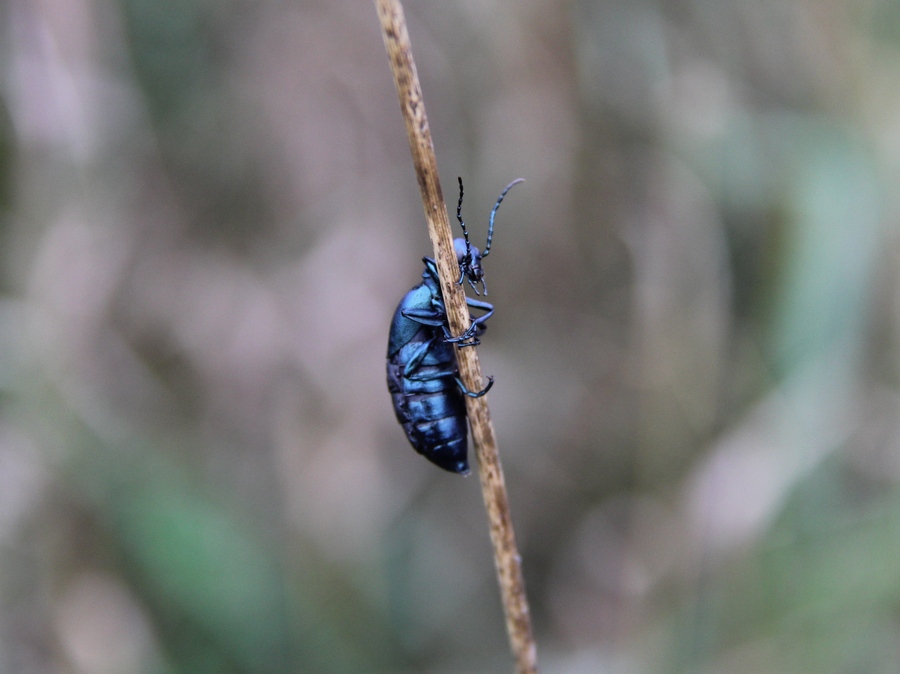 Caught in quivering flames
Caught in quivering flames
of fear
too vulnerable to see or hear
deafened by blame and loss –
I listen again to the Quiet.
I stand empty
at the altar of emptiness
bowing to goodness
to wisdom
my singular refuge –
the heart’s great compassion
come what may.
Tears and trials
no pain too cruel
to forgo kindness.
Open and awake
beneath the canopy
of Truth
where the wild fruit softens
ripens and falls –
it has no choice.
I learn to abseil
the impossible heights
on a nameless track
trusting the voice
of the ancients –
weaned on the joy
of letting go.
Through our hurdles
and struggles
of body and mind
we arrive –
yes, we arrive
at the cusp of death
in one tender exhalation.
Better set our moral compass
to the truth of this moment
stay present
facetime with now
discard the burden
in its entirety.
There we will touch
impermanence
the karmic law
and taste this Noble Truth
of pain
and the ending of pain
leading us beyond
self-obsession.
Do imposters beg our attention?
evict them all
one in-breath, one out
two, three
impermanent
imperfect
impersonal.
O to see at last
stay the course
at the coordinates of faith
gratitude
clarity
and peace –
the heart will unfold kindly.
Soaked in forgiveness
bravely blessing what is sweet
or sorrowful –
every moment
passing away.
© Ayyā Medhānandī 2019
photo by Brenna Artinger @ Sati Sārāņīya Hermitage
A DAY OF SHARING GRATITUDE – September 15, 2019
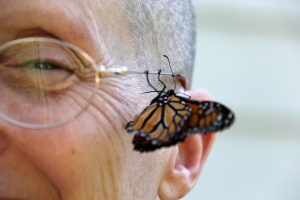
- 11:00 am Rice pindapat, offering food & blessing chant
- 11:30 Potluck meal
- 1:30–3 pm Meditation, Dhamma talk, and chanting
** Instead of a gift, please carpool if possible and kindly bring your own plate and fork/spoon to eat out of – this will lessen disposable waste.
A Week of Silent Meditation in August
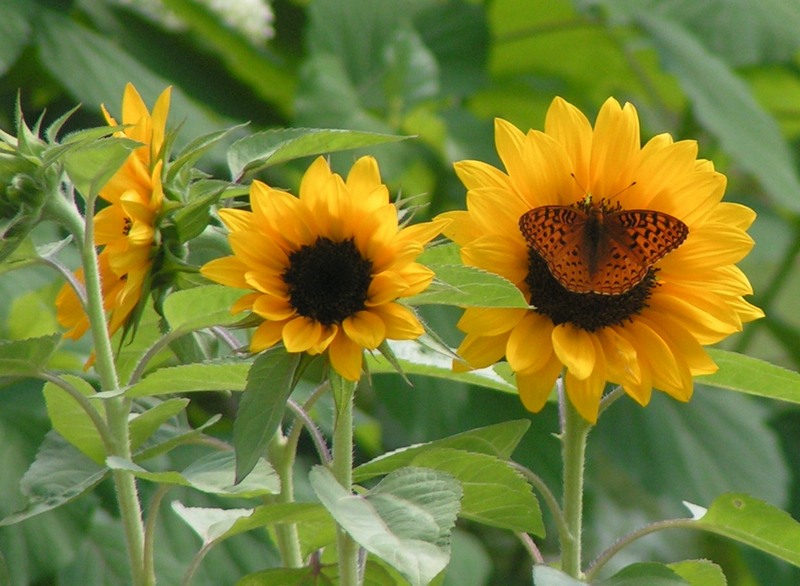 Join us for a week of silent vipassana meditation lead by Ayya Medhanandi and sponsored by Satipanna Insight Meditation Toronto (SIMT) from August 9-16, 2019.
Join us for a week of silent vipassana meditation lead by Ayya Medhanandi and sponsored by Satipanna Insight Meditation Toronto (SIMT) from August 9-16, 2019.
The venue for the retreat is Chapin Mill, a beautiful 135 acre purpose-built Buddhist meditation center run by the Rochester Zen community. It was founded by Philip Kapleau and is located in rural Batavia, near Rochester, upper New York state – 2.5 hours by car from Toronto, 6 hours from Ottawa.
Registration is now open. Contact SIMT for registration details.
Ayyā Medhānandī’s 70th – A Day of Sharing Gratitude
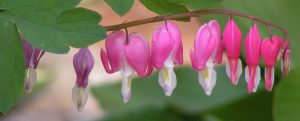
- 11:00 am Rice pindapat, offering food & blessing chant
- 11:30 Potluck meal
- 1:30–3 pm Meditation and Dhamma talk
Ajahn Candasiri’s Visit
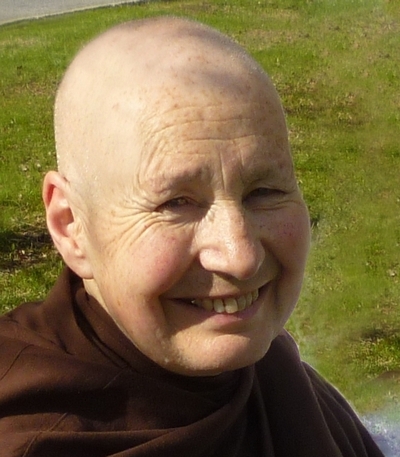
- Finding Joy – May 12, 2019, at the ordination ceremony of Anagārikā Jayasārā
- The Way of Kindness – May 14, 2019, at our community morning breakfast
THE NET OF OUR LONGING
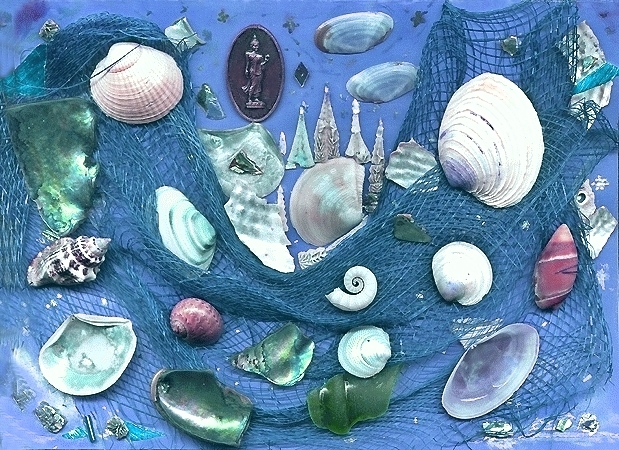
Wandering far
beyond vast seas and galaxies
our minds reach out
Beyond life’s web
we dream
searching for lasting beauty
But all we find
are fragments
caught in the net of our longing
And yet
And yet we stay the course
we endure
And soon
what felt like trials and losses
turn to treasure
What once were shells
tossed joylessly away
become temples
And through all danger or decay
we stay pure
steadfast
These miracles we witness ask
only to be remembered
and seen
for what they are
Invited
we enter
that blessed threshold
out of our innermost darkness
out of the chains
of fear.
Ayyā Medhānandī
© 2019
White Robes & Shaved Head
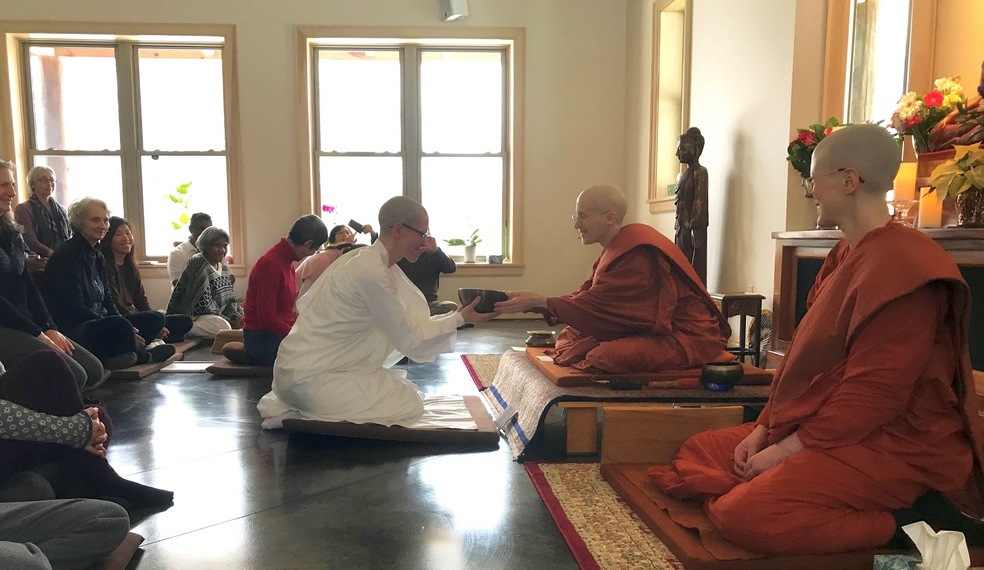 On an unusually warm winter afternoon, the last Sunday of November, many of us gathered together in the Temple to witness Anagārikā Kusalā (Lori Elling) enter the holy life as a postulant at Sati Sārāņīya Hermitage. Reflecting on the auspiciousness of this occasion, we recall the Buddha’s teaching:
On an unusually warm winter afternoon, the last Sunday of November, many of us gathered together in the Temple to witness Anagārikā Kusalā (Lori Elling) enter the holy life as a postulant at Sati Sārāņīya Hermitage. Reflecting on the auspiciousness of this occasion, we recall the Buddha’s teaching:
“…A person of good family who has gone forth from the lay life to homelessness… Being diligent, they become accomplished in virtue. But they’re not happy with that, and haven’t got all they wished for. They don’t glorify themselves and put others down on account of that. Nor do they become indulgent and fall into negligence regarding their accomplishment in virtue.
Being diligent, they become accomplished in training the mind. They’re not happy with that, and haven’t got all they wished for. They don’t glorify themselves and put others down on account of that. Nor do they become indulgent and fall into negligence regarding their accomplishment in training the mind.
Being diligent, they become accomplished in deep wisdom and insight. They’re not happy with that, and haven’t got all they wished for. They don’t glorify themselves and put others down on account of that. Nor do they become indulgent and fall into negligence regarding that deep knowledge and vision.
Being diligent, they attain unshakeable liberation.
Suppose there was a person in need of heartwood. And while wandering in search of heartwood they’d come across a large tree standing with heartwood. They’d cut out just the heartwood and depart knowing it was heartwood.
If someone with good eyesight saw that person, they’d say: ‘This mendicant knows what heartwood, softwood, bark, shoots, and branches and leaves are. That’s why they cut out just the heartwood and departed knowing it was heartwood. Whatever they need to make from heartwood, they will succeed.’
It’s impossible for that mendicant to fall away from the final end of the spiritual life, that unshakeable freedom of heart. . .”
from the Mahāsāropama Sutta, No. 29, Majjhima Nikāya
At the Core of the Coreless
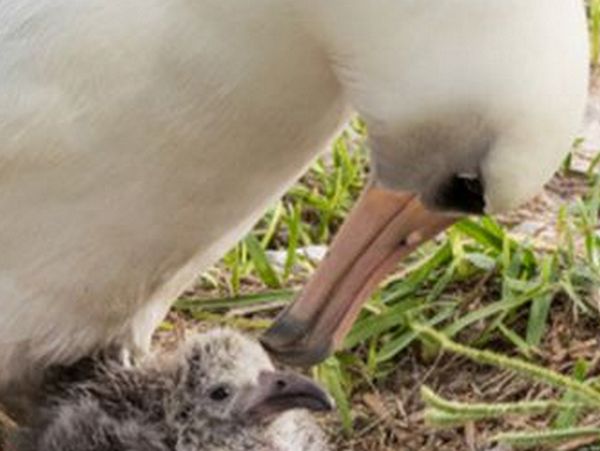
Audio Version – Ayyā Medhānandī Breakfast Reflections
I’ve talked quite a bit about the tornado and the eye of the tornado. And I spoke more about the winds circling around the eye than the eye itself. We tend to measure the speed and direction of such an intense wind storm but we don’t usually say much about the eye at its centre.
The interesting thing about the eye itself is that there is much to explore within that eye. That eye is actually eye-ness. It’s not an ‘I’, not a person. It’s not a personality. And it’s not ‘an eyeness’ either, because that could quickly be thought of as an ‘i’ with a ‘dot-ness’.
The most valuable and unique aspect of the Buddha’s teaching is that this I-ness is empty. It’s actually empty. But we mistakenly perceive it to be full – until we learn how to see.
And learning how to see is not something we can do conceptually. Our conceptual instrumentation is flawed. Not from birth, but from lack of training.
This particular path of practice and opening to this core which is coreless – that’s another thing. Language doesn’t capture it. It’s a core but it’s coreless. Like a banana tree. It’s a tree that has no core. Most trees if you cut them and look in, you find a core. But the banana tree has none. It’s coreless. And if you take it apart, there’s nothing inside it – nothing at all. Absolutely nothing.
So if you take this mind and study it deeply and look within it – look truly deeply within it! Look deeply within it and see through. You find nothing.
The finding of nothing is a very important discovery. We can’t discover it conceptually. It can only be discovered intuitively. During the process of discovering, necessarily we have to go through steps.
And those steps can be very painful.
There’s a beautiful analogy in the scriptures of a meditator being like a chicken in the egg and the meditation process is like the mother hen sitting on the egg – sitting on the egg and heating it up. And when the conditions are right, then there’s enough heat but not too much.
When the shell is mature and the little foetus inside is ripe to come out, then the thickness of the shell becomes something that the little chick can penetrate with its beak. And it starts pecking away until it makes a hole big enough for it to emerge.
But if the mother keeps getting up and leaving the egg, then these processes of the shell warming and the chick inside developing and the conditions for its breaking through never ripen.
So that can be used to describe a meditation practice which is sporadic. It does not have within it the right factors to develop the conditions for the mind’s ripening: the right warmth, the right attention, the right intention, the right clarity, the right consistency, the right commitment, the right effort, the right way of paying attention that warrants diligence, ardency, remembering to be present, to be studying, peering into the core so one-pointedly, so undistractedly that the whole process can mature and the chick can poke through the shell and see.
In this process, some of the necessary steps before the little chick can come out are its having to experience terrible pains, excruciating pains, unearthly pains – and at times very earthly pains. We feel all manner of pains: internal pains, external pains; what we think are pains, what we don’t think are pains; what we perceive to be mental pains, what we perceive to be physical pains; what we perceive to be internal pains, what we perceive to be external pains; what we perceive to be social pains, what we perceive to be psychological pains, what we perceive to be our pains, what we perceive to be other people’s minds pains.
We engage in receiving those pains in ways that are unbearable, and we blame others or we blame ourselves; or we don’t blame anyone. We just feel hopeless, helpless, lost, unequal to the task, incapacitated, inadequate, oppressed, pressured – wanting to get out, wanting to run away. Wanting, Craving. We fall back into deeper and deeper states of exaggerated craving. And this, of course, does not make the process of opening ripen.
It doesn’t lead to the celebration of that opening – that ability to see through. Instead, it misdirects us. We flap around a lot, and in our flapping we can create quite a mess. And we feel even worse for all our effort. Then we make up our minds – this is a waste of time, this is harming, this needs to stop. That’s very common. It’s classical. We feel sure,“This is harming.” So we have to stop!
That’s to our detriment because all of us are capable of opening. I know many women have described the pain of labour. Perhaps it’s one of the most intense pains that a person intentionally experiences – because she knows it’s result is that the little chick is allowed to come out.
In this process we don’t realize that we are in labour. But we have other pains that simulate that – like a mental pain. It’s a heart pain, not a physical pain. By mental we don’t mean brain. It’s really important to distinguish that. It’s not cerebral pain but it’s a pain of the heart.
So the pain of the heart is a cracking open. It’s a complete cracking open. It’s a seeing, it’s a bearing with. And it may be excruciating, but we bear with it. We bear with it, we take care. We take care of the body the best way we can. And we take care of the mind the best way we can.
We don’t accelerate. We don’t try to manipulate the process or speed it up. We are just patient with it, realizing that this is an important and difficult ascent. It’s an ascent of the highest mountain; or it’s a descent into the deepest possible space that exists in this world.
That’s how vast the journey is. How magnificent and immeasurable the whole process is. And it has to unfold karmically. We can’t intentionally speed it up because of craving, because of wanting a result, or expecting it to be a certain way and have it the way we like. This is all delusion – because the opening is a very major letting go. And that’s why it’s so excruciating – because we’ve been taught not to let go!
Yes, because we’ve been taught to cling, to own, to have, to possess, to increase, to inflate, to expand, to broadcast and receive results; to be gratified and have it pleasurable, have it satisfying, have it protecting us, keeping us well – so to speak – according to our socialized, acculturated definitions of getting well, and all of that.
But in this letting go, it’s like the letting go that those little boys in the cave in Thailand experienced. They were in the dark, they had no food, they could barely drink water – just a little drip-drop from the walls of the cave. And they were terrified. Because they were alone, abandoned, lost, down in the bowels of the earth.
So what a magnificent thing they were able to do because their teacher helped sustain them and guide them to be like little chicks in the dark within a shell, breaking through and able to see within their own body-mind process the corelessness, fearlessness, true deathlessness, the dying to the craving to get out, to be rescued, to be found.
He was able to help them – and they were captive. There was nowhere to go, nowhere to run, nothing to run to. No succor of any kind. No comfort. No tangible oxygen tank or hero to carry them away in his or her arms. There was just facing death, disappearance, destruction.
But within the corelessness of their own little body-mind processes, they could find some space, some place, some way of being that went beyond all the panic, anxiety, fear and helplessness. They were able to go beyond that and touch it.
It’s very much what we’re doing here. And it feels artificial – because it is. How many people would choose to climb into an oven and bake? Do that, even heat the place up, or overheat the body – and look at your mind.
So by our choice of staying within these cloisters, we’re like chicks in a little dark space, little Thai boys in a cave and we feel like we’re trapped. This is because the mind is too frightened, too immature, too unripe to go into that corelessness and let go of the world enough to be able to see through. Not just to see.
Seeing isn’t enough. We have to see through our conditioning. We have to see through our blockages. We have to see through our clinging. We have to see beyond our craving.
We have to see through our enslavement to having all the things that we can experience through the sense doors – and we have to only use the mind door, the heart door.
Sit in front of it. Sit in front of it and be with it, examine it, know it, taste it, touch it, until we see that it doesn’t exist. There is no door. It’s just an empty space. We are already in that. We are that. We’re nothing less than that – and yet – we are nothing.
In the emptiness of all impurity in the mind, we begin to see through. We see not just the arising of phenomena in consciousness due to our attachment, and our wanting things to arise in consciousness so that we can feel alive, but we begin to see through to the ending of phenomena in the mind. We begin to see through to the ending of phenomena in the heart – taking up one by one the detrimental observations of phenomena, and what is detrimental to their emptying.
We see what is detrimental, we see what diminishes us – and what takes us back to clinging. We see that. We see how it begins and how it ends. We see the ending of it.
At first it’s very frightening to see the ending of things. But in seeing the endings, craving is also ended – the ending of craving and the ending of attachments. We see the ending of hanging on to things that we trust and that we don’t even know we’re hanging onto because we haven’t stopped long enough, perseveringly enough, committed enough to see through.
In observing the endings and not being terrified by that, we start to taste the interior. Tasting the ending, tasting the emptying out is a wonderful moment. And it gives us a sense of trust, an “O, what is that?” moment. Something to experience, to know, to feel, to be with – without being. To burn everything for that.
In the burning up of all that is familiar and safe that we think we know, we discover that which cannot be burned. We discover that which is unburnable. In that corelessness there is the unburnable, the pure, tasteless, nothing to cling to, nothing at all – that is a total freedom.
It’s difficult to trust that there is something we have without experiencing it. Faith is a difficult quality to develop. But without it we are lost – lost in our doubt, lost in our ideas, and our self-view – which is the biggest prison of all. In the meditation practice we have the opportunity to develop that trust through our own insight. No one else can give that to us.
Once we develop even a little bit of trust, and we spend even one moment in that place that is so pure, we want to give more and more to it. We are willing to stay in the cave to do that. It’s very rare that beings can stay in the cave. Most people want to run out into the sunshine.
But the imperceptible light within us is even greater. It can light up the whole world. In the dark of night, it can light up our hearts – even in the middle of the greatest storm.
© Ayyā Medhānandī 2018
Blessed by Ajahn Sucitto
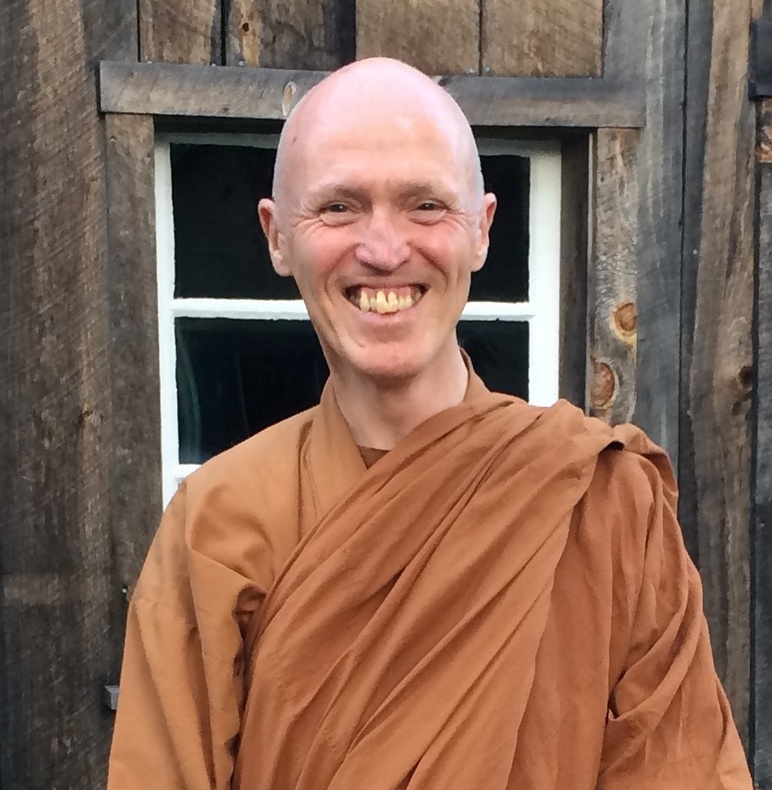
In mid-September, we were blessed to welcome Ajahn Sucitto to Sati Saraniya Hermitage for a joyful sharing of the Dhamma. We marvelled at the benevolent impact of his wise, gracious presence on our inner well-being, and how – both during and long after his visit – we experienced the profound virtues of kalyanamitta so frequently extolled by the Buddha.
In the spontaneity and fullness of this occasion, no recordings were made. Fortunately, Ajahn Sucitto’s talks are freely and widely available.
In one of his recent reflections, The Practice of Inclusivity, Ajahn Sucitto describes how our external and internal worlds come to be built upon exclusion. And he encourages us to give up the exhausting endeavor of excluding the uncomfortable in favour of meeting the suffering of the 1st Noble Truth. In this way, we can release suffering through embodied presence with all that arises.
Almsgiving Sept. 30th, 2018
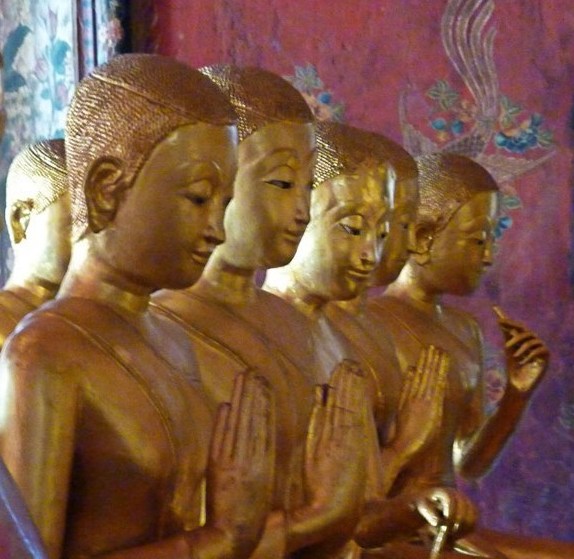
“The revival of the bhikkhuni tradition is…the most significant development for the Theravada tradition of the 21st century.” Bhikkhu Analayo
With respect to the bhikkhu ordinations at Tisarana Buddhist Monastery on Sept. 16th, we have delayed our annual almsgiving ceremony this year to September 30th.
Traditionally, we celebrate the Theravada Bhikkhuni Sangha by paying homage to the Buddha’s mother, Arahant Mahapajapati Theri and all the arahant bhikkhunis of ancient times and down through the ages.
This year, we also rejoice in the restoration of full-ordination for Theravada Buddhist women emerging in this second millenium and the growth of our community here in Perth, Ontario. And, at this time, we feel especially blessed that Ayya Anuruddha’s Permanent Resident status in Canada has been granted!
The program will be as follows:
10:00 am: Almsgiving ceremony, precepts, meal blessings and dana potluck meal
1:30 pm : Chanting, meditation and Dhamma teaching
If possible, please carpool for this event. We look forward to welcoming you.
